You’ll find success with these proven neem oil treatments: basic spray (1-2 tablespoons per gallon), concentrated formula for heavy infestations, neem-soap solutions for better adherence, weekly preventative applications, targeted foliar sprays for leaf undersides, soil drenches for systemic protection, quick daily spot treatments, cold-pressed formulas for organic gardens, and large-area emulsions. Always apply during cooler morning or evening hours, focus on leaf undersides where whiteflies cluster, and reapply every 7-14 days. These thorough methods will transform your pest management approach.
Basic Neem Oil Spray for Adult Whiteflies
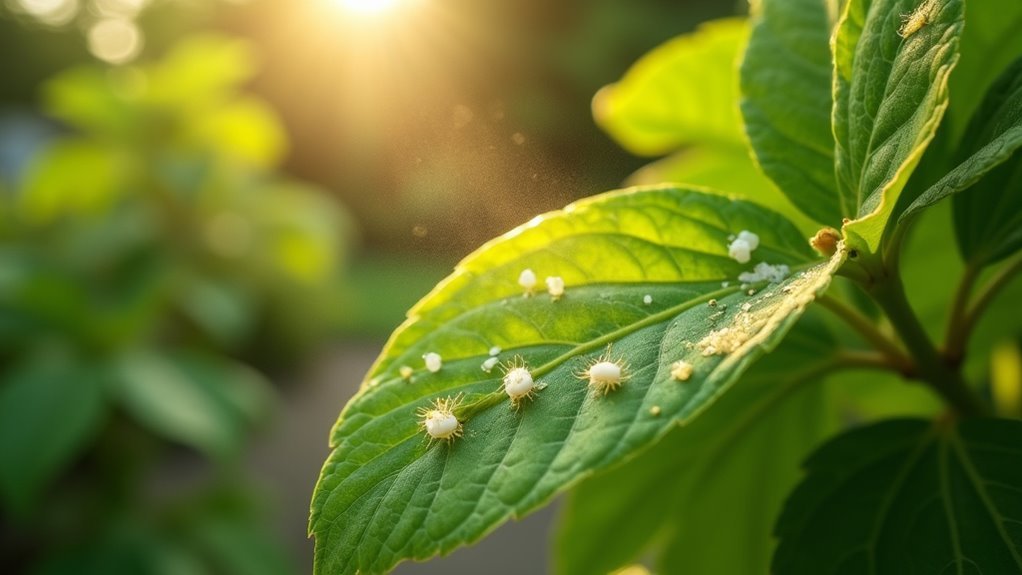
When adult whiteflies swarm around your plants, you’ll need a straightforward neem oil spray that targets these persistent pests effectively.
Mix 1-2 tablespoons of neem oil with one gallon of water, adding several drops of liquid soap to help emulsify the solution. Focus your application on leaf undersides where adult whiteflies typically gather, ensuring thorough coverage for maximum impact.
This natural insect repellent disrupts whitefly feeding and reproductive cycles, making them less likely to return.
Apply during early morning or late evening hours to prevent sunlight from degrading the oil’s potency. Reapply every 5-7 days or after rainfall to maintain consistent protection. Regular applications will considerably reduce whitefly populations over time.
Neem Oil and Soap Solution for Enhanced Coverage
You’ll boost your neem oil’s effectiveness against whiteflies by combining it with liquid dish soap in the right proportions.
The soap acts as a surfactant that helps the solution stick to leaf surfaces and penetrate better, giving you superior coverage where whiteflies hide.
Getting your mixing ratios, application timing, and reapplication schedule right guarantees you’ll achieve maximum control over these persistent pests.
Mixing Ratios and Proportions
Creating an effective neem oil solution requires precise measurements to maximize its impact against whiteflies. You’ll need to combine 1 tablespoon of neem oil with 1 gallon of water and 1-2 teaspoons of liquid dish soap. This soap solution helps break down the neem oil while improving adherence to plant surfaces, guaranteeing thorough coverage where whiteflies typically hide.
Essential mixing guidelines:
- Mix thoroughly to guarantee proper emulsification of all ingredients
- Test on a small plant section first to check for adverse reactions
- Apply during cooler temperatures – early morning or late evening preferred
- Reapply every 5-7 days or after rainfall to maintain effectiveness
The soap component is vital for creating a solution that’ll stick to both leaf surfaces, giving you better control over whitefly populations throughout your garden.
Application Technique and Timing
Three vital factors determine the success of your neem oil application: timing, technique, and thoroughness.
You’ll achieve effective coverage by spraying during early morning or late afternoon when temperatures are cooler. This application technique prevents leaf burn and enhances absorption while avoiding direct sunlight damage.
Focus your spraying efforts on both leaf tops and undersides, since whiteflies primarily feed underneath leaves.
Guarantee complete coverage of these essential areas where pests congregate and reproduce.
Maintain consistent treatment by reapplying your neem oil solution every 5 to 7 days or immediately after rainfall.
Monitor your treated plants closely for ongoing whitefly activity, adjusting application frequency based on pest population levels you observe.
This systematic approach maximizes neem oil’s effectiveness against whitefly infestations.
Coverage and Reapplication Schedule
When mixing neem oil with soap solution, you’ll create a more effective treatment that clings better to plant surfaces and penetrates whitefly hiding spots.
You’ll need one tablespoon of neem oil per liter of water, plus several drops of liquid soap for enhanced adherence. This combination guarantees thorough coverage on both leaf surfaces, targeting whiteflies’ preferred feeding areas underneath.
Your reapplication schedule should occur every 7-14 days to maintain effectiveness against newly hatched populations. After rainfall or heavy watering, you’ll need to reapply sooner since the treatment washes away.
- Spray both upper and undersides of leaves for complete coverage
- Monitor plants regularly to assess treatment effectiveness
- Increase application frequency for persistent infestations
- Maintain consistent schedule to disrupt whitefly reproductive cycles
Concentrated Neem Oil Treatment for Heavy Infestations
Heavy whitefly infestations require a more aggressive approach than standard diluted treatments. Concentrated neem oil delivers powerful antifeedant properties that disrupt feeding and growth cycles effectively. You’ll need one tablespoon of concentrated neem oil per gallon of water, plus liquid soap for better leaf adherence.
Apply during cooler morning or afternoon hours to prevent sunlight degradation. This concentrated approach won’t harm natural enemies when used correctly, maintaining beneficial insect populations while targeting pests.
| Application Aspect | Heavy Infestation Protocol | Standard Treatment |
|---|---|---|
| Concentration | 1 tbsp per gallon | 1-2 tsp per gallon |
| Frequency | Every 7 days | Every 14 days |
| Coverage Priority | Leaf undersides critical | General spray adequate |
Repeat applications every 7-14 days until you observe no whitefly movement, ensuring thorough coverage on both leaf surfaces.
Weekly Preventative Neem Oil Application
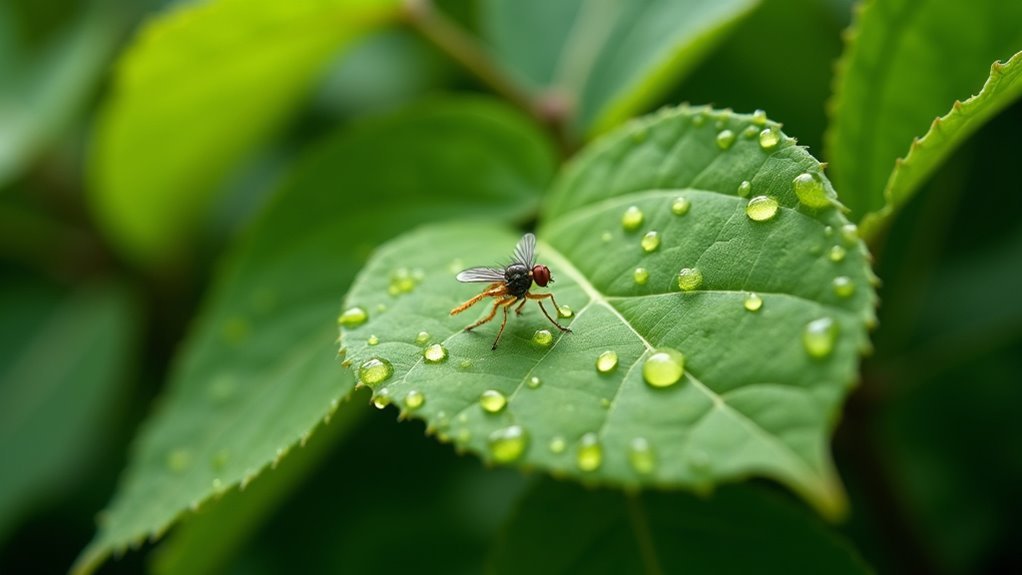
While reactive treatments address existing problems, establishing a weekly preventative neem oil routine protects your plants before whiteflies can establish damaging populations.
Mix one tablespoon of neem oil per gallon of water with a few drops of liquid soap for enhanced adhesion. This preventative approach disrupts whitefly feeding and reproductive cycles, making your plants less appealing to these pests.
Weekly neem oil applications create an invisible barrier that disrupts whitefly reproduction cycles, keeping populations from ever taking hold.
Apply weekly during peak whitefly season (late spring and summer) when activity increases. Neem oil acts as a natural antifeedant, reducing populations over time through consistent exposure.
- Mix at 1 tablespoon neem oil per gallon of water with liquid soap
- Apply weekly throughout the growing season for maximum protection
- Focus applications during late spring and summer months
- Spray both leaf tops and undersides for thorough coverage
Neem Oil Foliar Spray for Undersides of Leaves
Since whiteflies primarily cluster and feed on leaf undersides, your neem oil foliar spray must target these hidden areas where adults lay eggs and nymphs develop.
Mix one tablespoon of neem oil with one liter of water and add a few drops of liquid soap to enhance adherence. Apply this solution thoroughly to saturate both leaf surfaces, paying special attention to undersides where whitefly populations concentrate.
| Application Timing | Coverage Focus | Reapplication Need |
|---|---|---|
| Early morning | Leaf undersides | After rain |
| Late evening | Complete saturation | Heavy watering |
| Avoid midday | Hidden areas | Weekly schedule |
Spray during cooler hours to prevent rapid evaporation and improve plant absorption. You’ll need to reapply after rainfall or watering since neem oil washes off easily, reducing its effectiveness against whitefly infestations.
Dawn Dish Soap and Neem Oil Combination Treatment
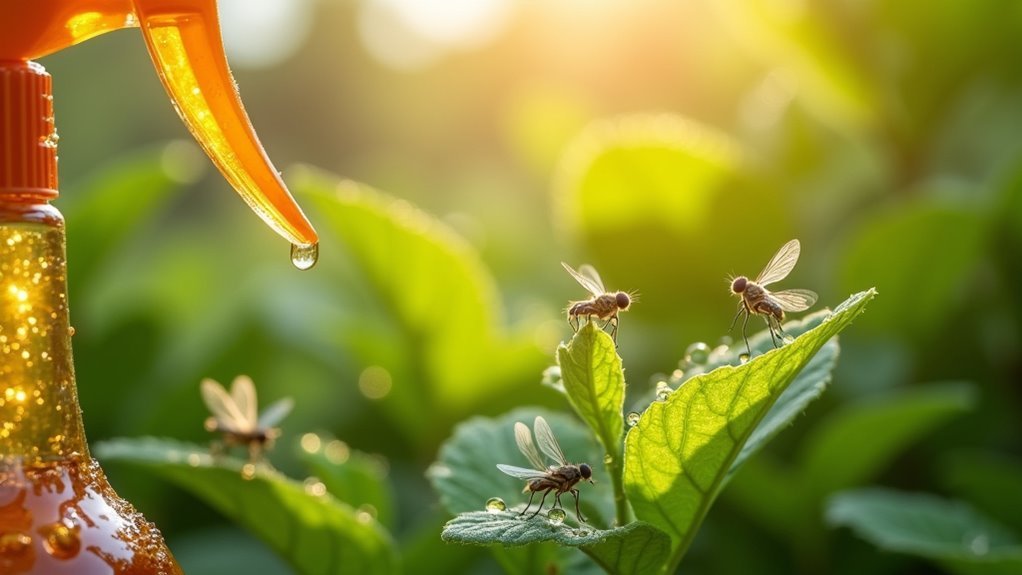
Combining Dawn dish soap with neem oil creates a powerful dual-action treatment that suffocates whiteflies while disrupting their feeding patterns.
This mixture enhances neem oil’s effectiveness by helping it break down and better coat the soft bodies of these persistent pests.
You’ll need to mix one tablespoon each of Dawn dish soap and neem oil per gallon of water. The soap acts as an emulsifier, allowing the neem oil to penetrate more effectively and target whiteflies where they’re most vulnerable.
- Apply thoroughly to both leaf tops and undersides where whiteflies typically hide
- Focus on undersides since that’s where they lay eggs and feed most actively
- Reapply every 7-14 days for sustained control over populations
- Retreat after rainfall to maintain protective coverage against re-infestation
Neem Oil Soil Drench for Systemic Protection
Beyond surface applications, neem oil soil drench creates systemic defense throughout your plant’s entire structure.
You’ll mix 1-2 tablespoons of neem oil per gallon of water and apply it directly to the soil around your plant’s base. Your plant absorbs these active ingredients through its roots, distributing them throughout its vascular system.
This systemic protection disrupts whiteflies’ hormonal balance, inhibiting their feeding and reproductive processes. You’ll notice stunted growth and development in existing populations.
The treatment provides long-lasting defense since neem oil remains active within your plant’s system, offering continued protection against future whitefly infestations.
Regular soil drench applications maintain ideal nitrogen levels, promoting overall plant health and increasing natural resistance to pest invasions.
Quick Daily Neem Oil Spot Treatment
You’ll get the best results by applying your neem oil spot treatment during morning hours when temperatures are cooler and whiteflies are less active.
Focus your spray coverage directly on affected areas, ensuring you coat both leaf surfaces thoroughly where whiteflies tend to congregate.
Stick to a daily treatment schedule for maximum effectiveness, especially during heavy infestations when these pests reproduce rapidly.
Morning Application Timing
While whiteflies remain less active during cooler morning hours, you’ll find this the ideal time to apply neem oil treatments for maximum effectiveness. The lower temperatures prevent rapid evaporation, allowing better penetration into plant leaves before daily heat stress begins.
Morning applications give you excellent conditions for thorough coverage of whitefly populations.
Mix neem oil with warm water and liquid soap for enhanced adherence during treatment. You can repeat these applications daily until you notice decreased whitefly activity, as the oil disrupts their feeding patterns effectively.
- Apply treatments during cooler morning temperatures to prevent oil evaporation
- Mix with warm water and liquid soap for better plant adherence
- Monitor whitefly activity immediately after treatment for effectiveness feedback
- Repeat daily applications until populations decrease considerably
Targeted Spray Coverage
Focus your neem oil applications on the undersides of leaves where whiteflies cluster most heavily, as this targeted spray coverage guarantees direct contact with the pests rather than wasting treatment on unaffected areas.
Mix one tablespoon of neem oil with a liter of warm water and two tablespoons of liquid soap for enhanced adherence. You’ll need to saturate all affected surfaces completely—simply spraying plants won’t reach many hidden whiteflies.
Apply this treatment daily until you observe no pest movement, as frequent applications disrupt their life cycle and feeding patterns.
Since neem oil’s safe for vegetables and can be used up to harvest day, you can treat edible plants without concern for chemical residues affecting your food safety.
Daily Treatment Schedule
Since whiteflies reproduce rapidly and develop resistance quickly, establishing a consistent daily neem oil treatment schedule becomes essential for breaking their life cycle before populations spiral out of control.
You’ll need to mix one tablespoon of neem oil with a liter of warm water and two tablespoons of liquid soap for each application. Apply this solution daily to your vegetable garden, ensuring you cover all affected plants thoroughly.
The key is persistence – continue treatments until you observe no movement among the whiteflies.
Time your applications strategically:
- Early morning treatments (6-8 AM) when temperatures are cooler
- Late evening applications (7-9 PM) to avoid direct sunlight degradation
- Monitor plants closely after each daily application for pest activity
- Adjust concentration if needed, but maintain consistent daily coverage
Cold-Pressed Neem Oil Formula for Organic Gardens
Gardeners seeking an effective, organic solution for whitefly control will find cold-pressed neem oil to be one of nature’s most reliable pest management tools.
This natural extract contains azadirachtin, which disrupts whitefly feeding and reproduction while maintaining safety for beneficial insects when applied properly.
Create your formula by mixing 2 tablespoons of cold-pressed neem oil with 1 gallon of water, adding 2-3 drops of liquid soap for better plant adhesion.
Apply this solution every 7-14 days, focusing on leaf undersides where whiteflies typically feed and remove eggs.
The oil’s systemic properties help prevent new infestations while reducing existing populations.
Unlike synthetic pesticides, this eco-friendly approach protects your garden’s natural ecosystem while effectively managing whitefly problems organically.
Neem Oil and Water Emulsion for Large Area Coverage
When you’re treating large areas for whiteflies, you’ll need to create an effective neem oil emulsion that covers extensive ground without losing potency.
Getting your mixing ratios right guarantees you don’t waste product while maintaining the strength needed to control whitefly populations.
Your application technique becomes vital since uneven coverage can leave untreated areas where whiteflies can continue to thrive and spread.
Proper Mixing Ratios
Although whitefly infestations can seem overwhelming across large garden areas, you can create an effective neem oil emulsion by mixing 1 to 2 tablespoons of neem oil per gallon of water. This solution suffocates whiteflies and disrupts their feeding patterns, providing reliable population control.
- Add liquid soap: Include 1 to 2 teaspoons of liquid soap to enhance emulsification and improve adherence to plant surfaces.
- Calibrate your sprayer: When using hose-end sprayers, guarantee even distribution across all targeted areas for consistent coverage.
- Time your applications: Apply during cooler parts of the day to minimize evaporation and maximize treatment effectiveness.
- Maintain regular schedule: Reapply every 7 to 14 days or after rainfall to prevent whitefly populations from resurging.
Application Coverage Techniques
Since whiteflies cluster mainly on leaf undersides where they feed and reproduce, you’ll need to ascertain your neem oil emulsion reaches these hidden areas for maximum effectiveness.
Your application coverage techniques must prioritize thorough spraying of both upper and lower leaf surfaces. Use a hose-end sprayer that’s properly calibrated to ascertain even distribution across large areas. Focus especially on infested leaves where whitefly populations are densest.
Apply your neem oil solution during cooler periods—early morning or late afternoon—to prevent rapid evaporation and improve plant absorption. Regular application every 5-7 days is essential since neem oil has a short residual life.
Reapply immediately after rainfall to maintain consistent protection against whitefly infestations.
Frequently Asked Questions
Is Neem Oil Effective Against Whiteflies?
Yes, you’ll find neem oil highly effective against whiteflies. It acts as an antifeedant that deters feeding, reduces populations over time, and doesn’t harm your vegetables when you apply it regularly.
What Is the Most Effective Treatment for Whiteflies?
You’ll find neem oil mixed with water and liquid soap most effective against whiteflies. Apply it daily to both leaf surfaces until you see no movement, especially during cooler weather for maximum results.
What Are the Downsides of Neem Oil?
You’ll face frequent reapplications after rain, potential leaf burn in high temperatures, and possible harm to beneficial insects. Neem oil’s effectiveness varies by formulation, and you might need additional methods for severe infestations.
What Is the Best Insecticide for Whiteflies on Reddit?
You’ll find Reddit users consistently recommend neem oil as the top organic insecticide for whiteflies. They suggest mixing it with liquid soap, applying thoroughly to both leaf surfaces, and reapplying regularly for best results.
In Summary
You’ve got ten proven neem oil treatments to tackle whitefly infestations at any stage. Whether you’re dealing with a minor problem or severe outbreak, there’s a solution that’ll work for your garden. Start with preventative weekly applications, then escalate to concentrated treatments if needed. Remember to target leaf undersides where whiteflies hide, and don’t forget soil drenches for systemic protection. You’ll see results within days of consistent application.

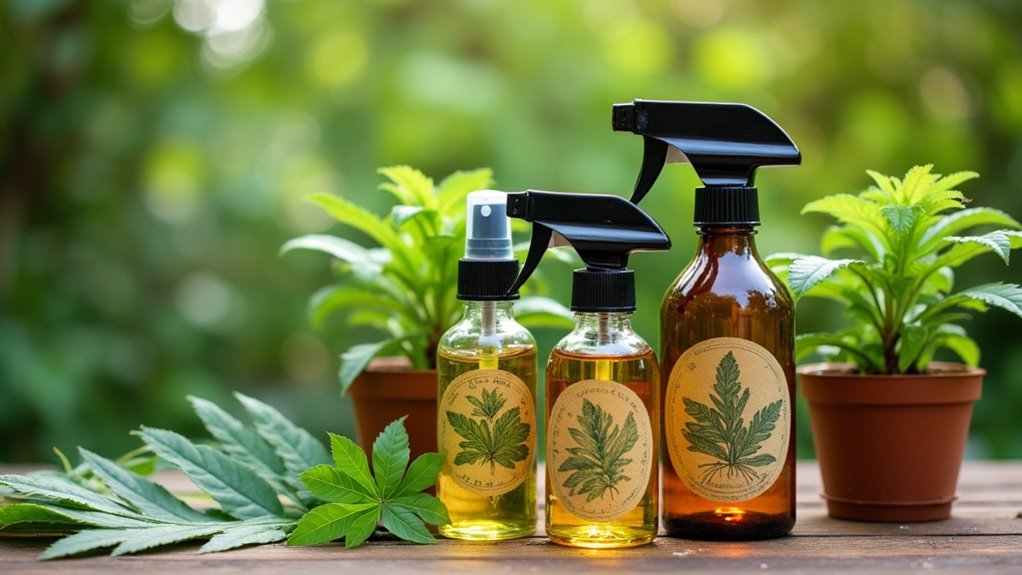


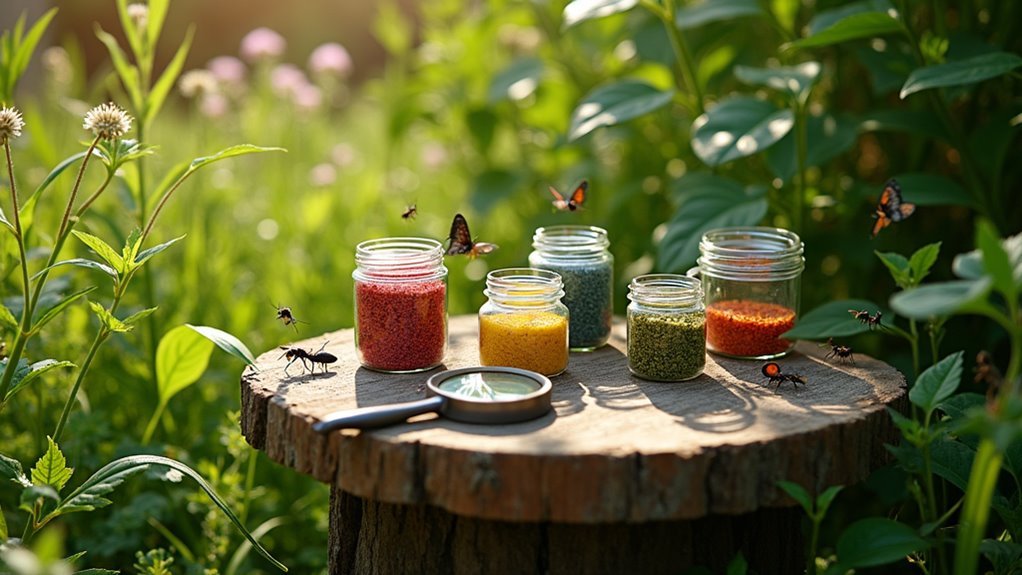
Leave a Reply